Six Decades of Spielberg
Steven Spielberg is the most famous and one of the most influential film directors on the planet. Over the course of more than half a century in the film industry he has turned his hand to just about every conceivable genre, from horror to sci-fi, spy thriller to period drama, fantastical family fare to gruelling grownup odysseys, crafting countless iconic movie moments and numerous films quite rightly considered among the greatest of all time.
Spielberg’s long career has moved with the times and can roughly be divided into thematic eras, so to mark his sixth decade in feature filmmaking we have undertaken the monumental task of picking just one film for each 10 years he has worked professionally behind the camera, selecting the movies that best typify his filmmaking style at the time.
Dear reader, welcome to Six Decades of Spielberg. Cue the John Williams fanfare.
1970s: Jaws (Birth of the Blockbuster Era)
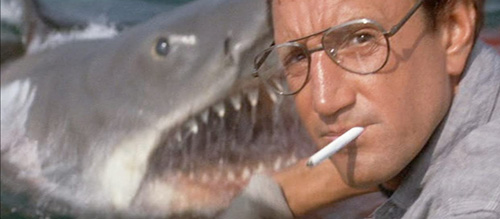
In the early 1970s, after proving himself by directing for television (including the pilot episode of ‘Columbo’), Steven Spielberg made the successful move to feature filmmaking in 1971 with taut chase movie Duel. Shortly thereafter he changed cinema forever.
The film that really put him on the map was Jaws, an adaptation of Peter Benchley’s bestselling novel that transcended a famously troubled production involving overruns, cast clashes and a broken shark to become one of the first films that could be considered a true summer blockbuster.
The popular seaside town of Amity Island is terrorised by a huge great white shark. Police Chief Brody (Roy Scheider) must team up with marine biologist Hooper (Richard Dreyfuss) and shark hunter Quint (Robert Shaw) to find and catch the creature to end its feeding frenzy.
As British critic Mark Kermode regularly alludes to in his radio appearances, this shark movie “isn’t really about a shark”. Behind the movie magic and exciting set pieces, this is really about families, community and humanity’s best and worst instincts. How many times, particularly in recent years, have we seen elected officials like Amity’s Mayor Vaughn (Murray Hamilton) show callous disregard for death tolls over economic concerns? How many times are the opinions of experts in a particular field dismissed over what your neighbour heard a rumour about? Just how far would you go to protect your family from any threat, up to and including a millions-of-years-old eating machine?
With Jaws, Spielberg offers a steady build of tension and dread (the simple and terrifying John Williams theme helps no end), the well-timed implementation of horror movie conventions (classic jump scares and not showing the killer until absolutely necessary), and elegant three act storytelling. But, without top-notch character work, all that would count for nought; it’s the fully-rounded characters and their relationships that give this film its staying power.
Some of the issues on set were a blessing in disguise. Richard Dreyfuss clashing with Robert Shaw and Roy Scheider playing peacemaker added a genuine note to the dynamic of Hooper, Quint and Brody in the final act. The mechanical shark, nicknamed “Bruce” after Spielberg’s lawyer, did not perform well as soon as it was introduced to salt water and thus had to be shot around for 80% of the film, adding an air of mystery and unseen menace that may never have existed.
Crowds turned up in droves, making Jaws the hit of the summer, breaking records at the time with a $7million opening weekend and eventually grossing $476million worldwide against a $9million budget, proving beyond doubt how big movies could be with the right hook, enough spectacle and a well-timed release.
Spielberg would see out the decade by releasing Close Encounters of the Third Kind, a quite different but almost as successful genre deconstruction again starring Dreyfuss. His career as a highly sought-after director had truly begun.
1980s: E.T. the Extra-Terrestrial (Family Upheaval Era)
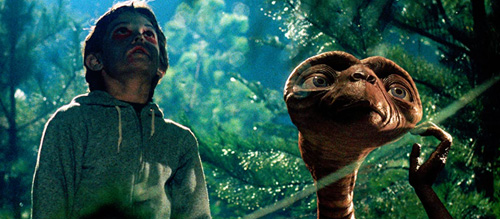
The movie that gave Steven Spielberg’s production company Amblin its iconic logo of a boy and his alien on a bike silhouetted against the full moon completely epitomises his family filmmaking.
“Amblinesque” is a descriptor now when applied to such nostalgic properties as ‘Stranger Things’ because of movies like E.T. and the Spielberg-produced The Goonies, the memorable characters, effervescent tone, and timeless and universal themes of friendship in these stories having nurtured an entire generation who grew up in the 1980s.
Ten year-old Elliott (Henry Thomas) discovers an alien who has been accidentally left behind on Earth. Together with his brother and sister, he decides to help the alien to return home, all the while keeping “E.T.” hidden from his mother and sinister government authorities.
Only through a child’s uncynical eyes could this story be so magically and movingly told. Young Elliott, his journey, his heart and his heartbreak are the singularity around which everything else helplessly orbits. E.T. and Elliott form an empathic bond beyond an ordinary friendship, and before long E.T.’s actions are having a noticeable effect on his new friend’s behaviour and eventually his health, and both begin to rapidly decline as the alien’s link to his people grows weaker.
Spielberg is one of the greatest directors of children, and the performances of Henry Thomas and Drew Barrymore (as his little sister Gertie) never feel anything less than natural, little touches like playing games on set and keeping the E.T. puppet moving between takes helping to keep the magic alive.
Some of Spielberg’s go-to genre storytelling tropes began here – distrust of government agencies; families with absent fathers; kids’ imaginations providing solace from trying circumstances – and all have rarely felt more poignant, each heightened by John Williams’ magical musical accompaniment.
Spielberg dipped into unusual and often upsetting family experiences in his stories throughout the 1980s, from siblings, parents and children torn apart by prejudice and war in The Colour Purple and Empire of the Sun to Indiana Jones’ complicated and resentful relationship with his dad in Indiana Jones and the Last Crusade.
1990s: Saving Private Ryan (Trauma and Innovation Era)
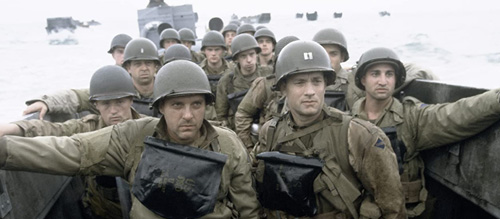
The 1990s saw Spielberg make one of the all-time great crowd-pleasing blockbusters with Jurassic Park, but seemingly in counter-point to providing audiences with such pure escapism, he began to look inward, to self-reflect and analyse humanity’s relationship to historical trauma. This era was highlighted by the harrowing Schindler’s List, the powerful Amistad, and the relentlessly visceral Saving Private Ryan.
In 1944, a squad of US soldiers led by ex-teacher Captain Miller (Tom Hanks) is given a mission to find the last Ryan brother fighting in Normandy. They are to deliver condolences regarding the death of Ryan’s three siblings and orders to take compassionate leave on the grounds that the US government hopes to spare a mother from losing all of her sons in one fell swoop.
It is Saving Private Ryan that perhaps best epitomises Spielberg’s career trajectory throughout the 1990s, balancing as it does staggering technical innovation (today it is still one of the most frequently cited stylistic influences on just about every modern war film from Black Hawk Down to 1917), startling action set pieces on a massive canvas, and heartbreak very much grounded in the real world.
You’re not really given a moment to orientate yourself here, flashing straight back from sombre remembrance of the fallen right into the thick of war, and then it refuses to let up for almost 3 hours.
Spielberg and screenwriter Robert Rodat’s mastery of economic character expression drives unshowy performances from the film’s ensemble (particularly Hanks), and Janusz Kamiński’s immediate, painfully real cinematography combines with this for a pretty potent cocktail.
Ryan is one of the few movies it has been deemed OK for insecure manly men to openly cry at, but any viewer is put through the emotional wringer in one of the truly great war films that’s all about familial love and the heartbreakingly high cost of conflict.
2000s: Minority Report (Future Blockbuster Era)
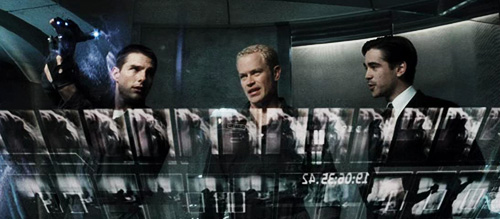
Spielberg’s films remained big-budget and visually flashy at the turn of the millennium, but he also plunged into exploring massive science-fiction what-if scenarios in addition to continuing with his usual fascination with fractured family dynamics. All three of his cerebral sci-fis from the 2000s (A.I. Artificial Intelligence, War of the Worlds and Minority Report), made for around the same budget and loosely adapted from works of literature, could be considered blockbusters, but it is the latter that was the most successful project.
In a near-future Washington, we follow the early days of the Precrime Initiative that predicts every future perpetrator of a violent crime and allows the police to arrest them before blood is spilt. When Captain John Anderton (Tom Cruise) is accused of being about to murder a man he has never met, he goes on the run with one of Precrime’s psychic “precogs” and attempts to unravel the mystery of his upcoming crime and the shady origins of the institution he works for.
Like most of Spielberg’s work, Minority Report is grounded in family, in this case a family torn asunder and still processing unimaginable presumed loss. That’s the most heartbreaking part of Anderton’s story; his living with the cruel uncertainty over whether his son is alive or dead. Samantha Morton’s Agatha and her precog brothers were likewise taken from their parents and used for dark ends by sinister authorities.
This is thrilling, intriguing stuff, with a gripping noir mystery plot that constantly wrong-foots you; a film that has no shortage of exciting futuristic set pieces – notably when Anderton hides in a grim apartment from spidery police drones, blinded as the clock ticks down to his newly transplanted eyes healing.
Probably the best way to adapt Philip K Dick’s writing is to use just a single intriguing idea as a basis for a whole new story, and here Spielberg and his screenwriters expand on the core premise to create a terrifyingly plausible authoritarian future.
2010s: Lincoln (Popcorn and Prestige Era)
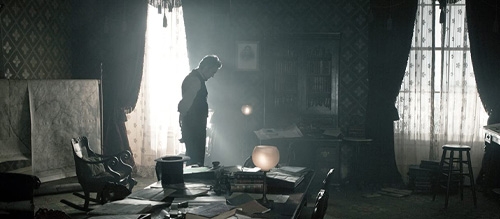
The technology-pushing The Adventures of Tintin and Ready Player One aside, the 2010s could be considered Steven Spielberg’s period of commitment to prestige filmmaking; telling powerful true stories of icons and world-shaping events. How can you tell you’re onto “Serious Spielberg” even before the film is released? Well, he’s normally photographed wearing a suit and tie on set, seemingly out of respect for the material and the people he is depicting on film.
The firmly mid-tier Spielberg movies War Horse, Bridge of Spies and The Post all have their memorable moments, but Lincoln stands high over them, even without the stovepipe hat.
One of Spielberg’s few straight biopics presents far from a simplistic view of Civil War-era America and the cloak-and-dagger strategies necessarily employed in the US House of Representatives. This film is not a sweeping decades-spanning epic cataloguing Abraham Lincoln’s (Daniel Day-Lewis’) eventful life, but a record of a messy, complicated time in a young country’s history, laser-focusing on just a few months in 1865 in the leadup to the passing of the Thirteenth Amendment.
The cast of this project is frankly the most ridiculously stacked of Spielberg’s career – Daniel Day-Lewis, Sally Field, Tommy Lee Jones, David Strathairn, James Spader, Joseph Gordon-Levitt, Hal Holbrook… (take a breath)… John Hawkes, Jackie Earle Haley, Tim Blake Nelson, David Oyelowo, Colman Domingo, Jared Harris, Walton Goggins, Adam Driver…
This is a grounded, naturalistic historical political thriller almost to a fault. The Gettysburg Address isn’t even delivered in the film in full by the president himself but split between several soldiers who witnessed it being delivered years earlier. The most entertaining moments come from the speeches in the House and the underhanded tactics employed to influence key votes, but the more compelling scenes are the domestic lulls between the Lincolns at home.
Day-Lewis was rightly acclaimed not just for fully inhabiting a giant of history but for making him flawed and human every step of the journey, a seemingly mild-mannered but passionate and deeply intelligent man trying to achieve the impossible: to reunite and reform his country.
2020s: West Side Story (Reminiscence and Nostalgia Era)
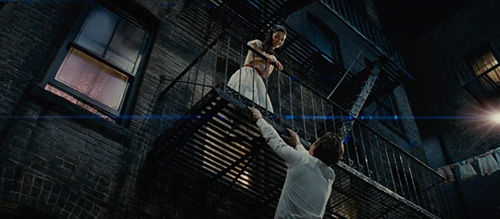
It might be too early to tell exactly what pattern this latest, perhaps last decade of Spielberg filmmaking will reveal, but from his first two films released in the 2020s he seems to be in a reflective, somewhat nostalgic frame of mind.
Spielberg has been very open about the heavily autobiographical nature of The Fabelmans, looking back on the experiences that made him the man and the artist he is, and midway through his seventh decade on Earth he finally turned his hand to one of his favourite genres: the musical.
West Side Story is the great modern re-telling of “Romeo and Juliet”, a love story across divides following Tony (Anson Elgort) of the Jets gang who falls for Maria (Rachel Zegler), the sister of the leader of the rival Sharks, their love having costly consequences for everyone in their orbit.
Spielberg had imbued his movies with musical flourishes in the past – 1941 and Temple of Doom both have their Broadway tribute scenes – but to choose your personal favourite musical to re-adapt and have compared to one of the most beloved musical films of all time was bold and no mistake.
Not content to simply re-stage the original in a modern filmmaking style, Spielberg and regular screenwriter Tony Kushner acknowledge the aspects of the stage show and original film that haven’t aged well and approach them differently, making the socio-political and racial angle more central to the story and giving the appropriate faces and voices their time in the spotlight, while never anachronistically taming the raging prejudices that were rife in the period the story is set in.
Spielberg’s favourite 1990s cinematographer Janusz Kamiński returns to give this reimagining of West Side Story an expressionistic flare, and the entire ensemble – particularly the supporting players Ariana DeBose and Mike Faist (as Anita and Riff respectively) – bring new dimensions and nuance to their characters in addition to belting out beloved songs with aplomb.
You don’t remake a classic unless you have a completely fresh take and are confident in your vision. Thankfully this is Steven Spielberg we’re talking about, and even with his nostalgia goggles on his artistic vision is seemingly without limit.
Recommended for you: Where to Start with Steven Spielberg

